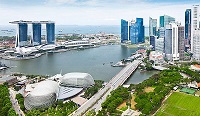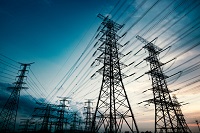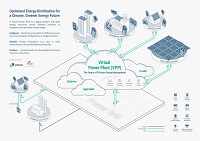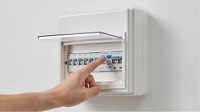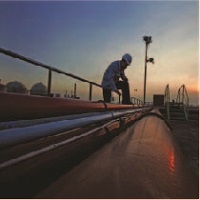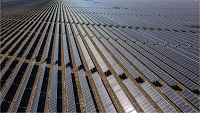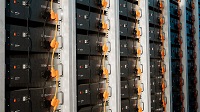- About EMA
- Our Energy Story
- Consumer Information
- Regulations & Licences
- News & Events
- Partnerships
About EMA
Who We Are
Learn about EMA’s leadership, milestones and accomplishments.
Join Us
Explore the career, scholarship and internship opportunities available in EMA.
Our Energy Story
Overview
Learn how the Singapore Energy Story charts the path to a net-zero future.
Energy Supply
Gain insights into the Four Switches powering Singapore towards a cleaner energy future.
Energy Demand
Discover ways to enhance energy efficiency and lower your carbon footprint.
Energy Grid
Explore how EMA ensures a reliable and secure energy supply for everyone.
Energy Market Landscape
Learn about the intricacies of Singapore’s energy market structure and operations.
Consumer Information
Electricity
Get tips on buying electricity and protecting your family from electrical hazards.
Gas
Learn about purchasing gas and safeguarding your family against gas hazards.
Solar
Access information on installing solar panels at your home and selling excess electricity to the national grid.
Regulations & Licences
Regulations
Stay up-to-date with the latest regulations, policies and frameworks governing the energy sector.
Licences
Learn about the licences that EMA issues to different stakeholders in the energy sector.
Regulatory Publications
Read about the Codes of Practice and Circulars that EMA publishes to regulate the energy sector.
Partnerships
Calls for Proposal
Collaborate with EMA in co-creating innovative solutions for the energy sector.
Consultations
Give your comments and feedback on EMA’s policies and regulations.
R&D Engagements
Discover how EMA works with stakeholders to catalyse new and innovative digital technologies.
Talent Development
Learn about EMA’s efforts in nurturing talent and cultivate interest in the energy sector.
eSERVICES
Get quick access to EMA’s services for application of worker licences, scholarships and more.
Government officials will NEVER ask you to transfer money or disclose bank log-in details over a phone call. Call the 24/7 ScamShield Helpline at 1799 if unsure. For more information on how to protect yourself against scams, please visit www.scamshield.gov.sg.
Our target is to import around 6 gigawatts (GW) of low-carbon electricity by 2035, which is around one-third of our energy demand then.
Overview
While Singapore has limited renewable energy resources, we are able to access low-carbon electricity that is abundant in the region by connecting to regional power grids. This also promotes the development of renewable energy in the region and paves the way in realising the ASEAN Power Grid vision.
Large-scale Electricity Imports
In July 2022, EMA invited interested companies to submit their proposals for importing up to 4 gigawatts (GW) of electricity in Singapore. The Request for Proposals (RFP) to appoint licensed electricity importers concluded as of 29 December 2023.
With the continued strong interest from credible parties to participate in electricity import projects, and to ensure adequate supply to meet Singapore’s future energy needs, Singapore is now seeking to import around 6 GW of low-carbon electricity by 2035, up from the initial target of 4 GW.
To date, EMA has issued Conditional Approvals to 11 projects to import low-carbon electricity from Australia, Cambodia, Indonesia, Sarawak (Malaysia) and Vietnam. Six projects have made substantive progress and were awarded Conditional Licences.
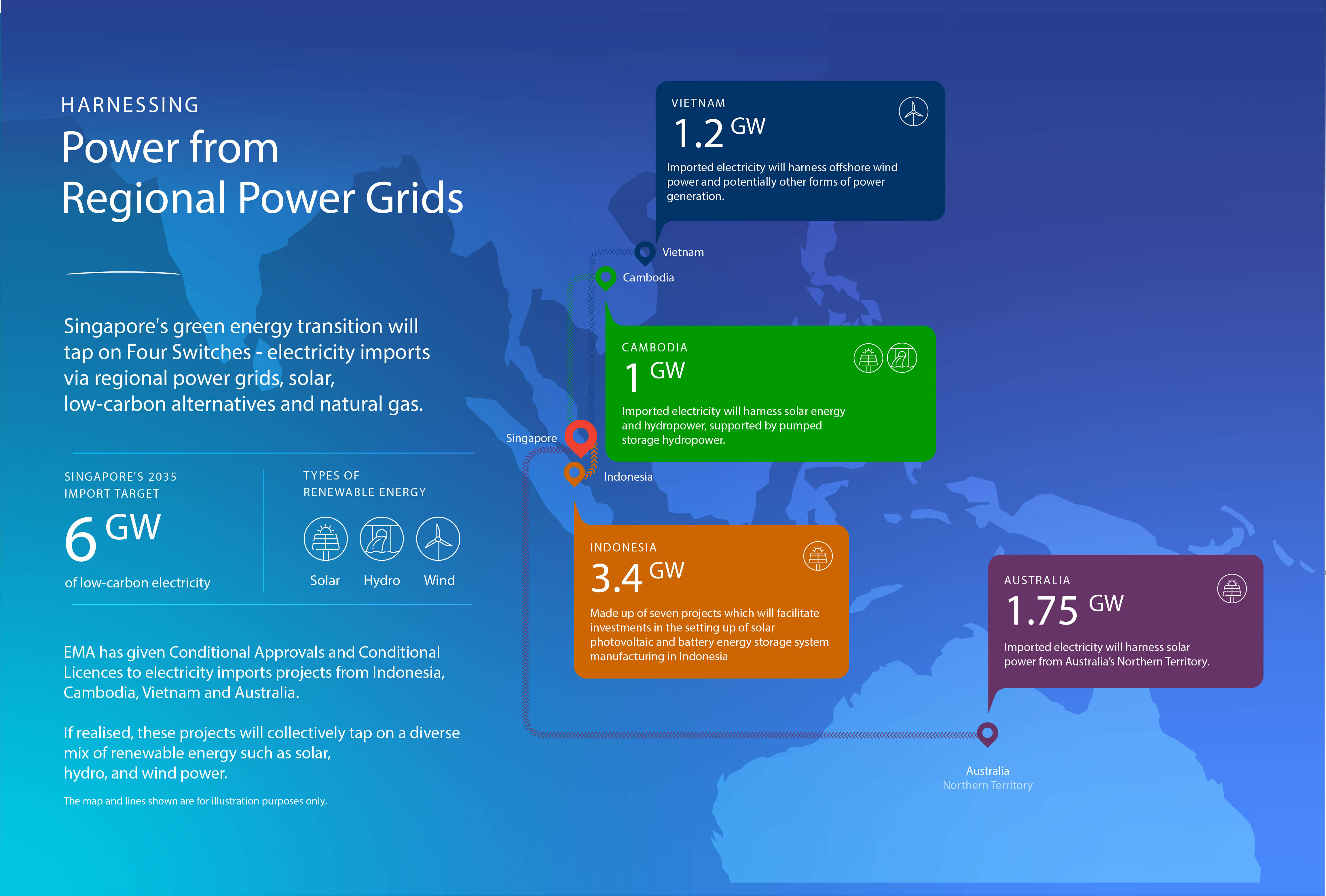
Table 1: Conditional Licences
| S/N | Company | Name of Contact Point | |
|---|---|---|---|
| 1 | Alamtri Solar International Pte Ltd | Mr Dharma Djojonegoro Mr Teuku Rengga Felamona |
dharma.djojonegoro@alamtri.com rengga.felamona@alamtri.com |
| 2 | Equator Renewables Asia Pte Ltd (Formerly known as EDPR Genco Pte Ltd) | Ms Nikita Yu | nikita@equatore.asia |
| 3 | Keppel Energy Pte Ltd (Indonesia project) | Mr Kenny Tan | kenny.tan@keppel.com |
| 4 | Pacific Medco Solar Energy Pte Ltd | Ms Clare Savereux | solar@pacificlight.com.sg |
| 5 | Vanda RE Pte Ltd | Mr Robin Pho | projectvanda@gurinenergy.com |
| 6 | Singa Renewables Pte Ltd | Mr Raye Lai Yong Chiang Mr Chintan Mehta |
raye_lai@pacificenergycorp.com chintan.mehta@totalenergies.com |
Table 2: Conditional Approvals
| S/N | Company | Name of Contact Point | |
|---|---|---|---|
| 1 | Keppel Energy Pte Ltd (Cambodia project) | Mr Andrew Toh | andrew.toh@keppel.com |
| 2 | Sembcorp Utilities Pte Ltd | Ms Leow Lay May | laymay.leow@sembcorp.com |
| 3 | Shell Eastern Trading Pte Ltd | Mr Lee Kuan Ming | Kuan-Ming.Lee@shell.com |
| 4 | Sun Cable (Singapore) Assets Pte Ltd | Ms Bo Sun | bo.sun@suncable.energy |
EMA continues to welcome interested companies to submit further proposals to import and sell low-carbon electricity in Singapore. EMA is open to consider awarding more Conditional Approvals to proposals that are sufficiently attractive and suitable.
Potential importers should showcase their supply reliability, credibility, track record, cost-competitiveness, and ability to manage the carbon output of their power generation supply.
Please click on the links below to download the documents:
Submission Requirements for Electricity Imports Proposals
Submission Register
Attachment A Submission Requirements
Template_A111
Templates_A222_A311_A334_A412_A521_A621_A622
Templates B21_B31
Template B51
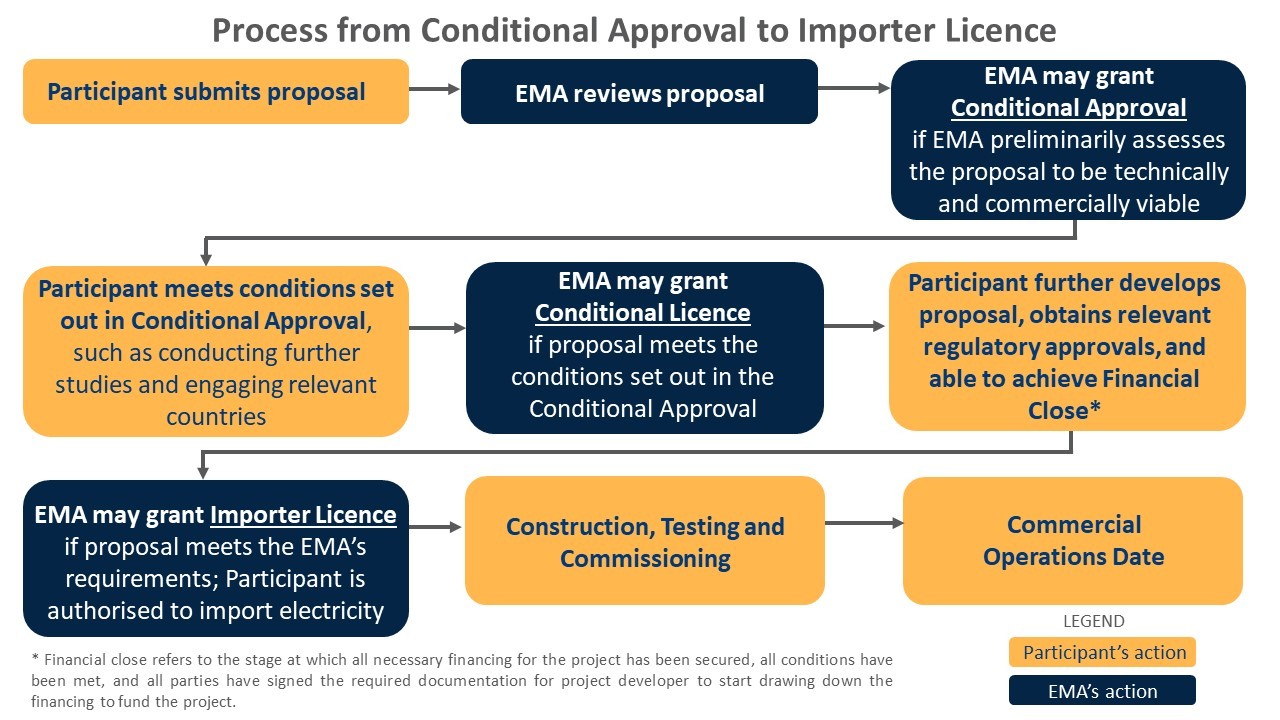
Import Trials
Lao PDR-Thailand-Malaysia-Singapore Power Integration Project (LTMS-PIP)
The LTMS-PIP marked the first multilateral cross-border electricity trade involving four ASEAN countries.
The first phase of the project, which launched in June 2022, saw up to 100 megawatts (MW) of renewable hydropower being imported from Lao PDR to Singapore through Thailand and Malaysia via existing interconnectors.
The second phase of the project will see electricity trading double to a maximum of 200 MW. This is facilitated by the introduction of multidirectional power trade where the additional supply will come from Malaysia.
100 MW Malaysia ENEGEM Pilot
The Malaysia Ministry of Energy Transition and Water Transformation (PETRA) issued a press release dated 15 April 2024, inviting interested and eligible parties to participate in the inaugural auction for the purchase of green electricity from Malaysia’s Electricity supply system to be supplied to Singapore via the Energy Exchange Malaysia (ENEGEM) Platform.
Sembcorp Power Pte Ltd will import 50 MW of renewable electricity from Malaysia's Tenaga Nasional Berhad (TNB) to Singapore for a duration of two years starting in December 2024.
Singapore Energy Interconnections Pte Ltd
Singapore Energy Interconnections Pte Ltd (SGEI), established in April 2025, is appointed by the Singapore Government to develop and operate cross-border electricity interconnections to enable power imports into Singapore. As a key enabler of Singapore's energy transition, SGEI works closely with industry partners and government stakeholders to ensure the technical and commercial viability of regional power infrastructure. SP PowerInterconnect (SPPI), a subsidiary of SP Group, is a technical partner of SGEI to provide expertise in project management and technical design, engineering and operation of transmission and distribution assets to facilitate low-carbon electricity imports into Singapore. For more information about SGEI, visit www.sgei.com.sg.
